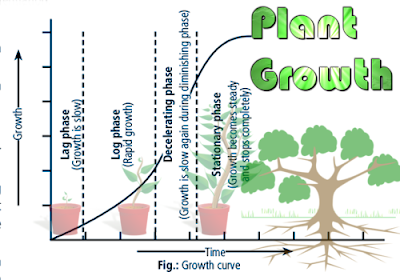Understanding Plant Growth
Q1: Define growth.
Answer: Growth in an organism consists of a permanent and more or less irreversible increase in size, commonly accompanied by an increase in dry mass and amount of cytoplasm.
Q2: Define development.
Answer: The coordination of growth and differentiation of a single cell into multicellular tissues and organs is called development.
Q3: How the growth of living beings is different from non-living?
Answer: Growth in living beings is intrinsic or internal, in contrast to extrinsic growth observed in non-living objects.
Q4: How is plant growth different from animal growth?
Answer: Plant growth is generally indeterminate, i.e., continued throughout life while animal growth is non-continuous i.e. after a certain age, the ageing starts leading to death. In plants, the growth is diffused and localised while animal growth is uniform.
Q5: How plant growth is categorised?
Answer: Growth in plants may broadly be categorised as:
① Primary plant growth
It results in elongation of plant parallel to its axis; contributed by root and shoot apical meristem and intercalary meristem.
② Secondary plant growth
It results in an increase in girth of the plant; contributed by lateral meristems such as vascular cambium and cork cambium.
Q6: List the factors affecting growth?
Answer:
① Nutrients
② Water
③ Oxygen
④ Temperature
⑤ Light
⑥ Gravity
⑦ Other factors like minerals deficiency etc.
Q7: Define differentiation.
Answer: It refers to the permanent qualitative changes in structure, chemistry and physiology of cell wall and protoplasm of cells, tissues and organs. It occurs by the activation or repression of some genes.
Q8: Define Plasticity
Answer: It is the ability to change under the influence of internal or external stimuli.
Q9: What is redifferentiation?
Answer: Structural, chemical and physiological specialisation of cells derived from dedifferentiated meristematic cells are called redifferentiation. e.g. Secondary phloem, secondary xylem, cork and secondary cortex are some of the tissues formed through redifferentiation.
Q10: List the four zones of growth in roots.
Answer:
① The root cap - in which protects the root.
② The zone of cell division in which contains the apical meristem.
③ The zone of elongation - in which extends the root through the soil.
④ The zone of maturation - in which cells become differentiated.
Q12: What are phytohormones?
Answer: Plant growth regulators (PGR) or plant hormones or phytohormones are small, simple molecules of diverse chemical composition, which though present in low concentration, regulate growth, differentiation and development.
Q13: List any three Growth Promoting Hormones.
Answer: Auxins, Gibberellins, Cytokinins
Q14: What is photoperiodism?
Answer: The effect of photoperiods or daily duration of light hours (and dark periods) on the growth and development of plants, especially flowering, is called photoperiodism.
Q15: What are growth movements or tropisms?
Answer: Tropism or growth movement is a type of plant movement. It is a directional movement that results from growth in a particular direction. These growth movements occur in response to elongation of selected cells.
Plants exhibit tropical growth in response to many signals that cover light, gravity, chemicals, and temperature.
Q16: What is senescence?
Answer: The breakdown of cell components and membranes that eventually leads to the death of the cell is called senescence.
☛See also
The Living World (NCERT Chapter Solutions)
The Living World (AIPMT 7 MCQs)
The Living World (Taxonomical Aids)
Biological Classification (NCERT Chapter Q & A)
Kingdom Fungi (AIPMT MCQs)
Plant Nutrition MCQs (AIPMT/NEET)
Plants Of Special Interests (Pre-Medical)
Environmental Biology MCQs (AIPMT/NEET)
List of Important Proteins
Animal Tissues (Part-1) V Short Q & A
Role of Micro and Macro Nutrients in Plants
Epidermal Tissue System in Plants (Important Points)
Classification of Plants
Biology MCQs(AIPMT/NEET/CET)-2

No comments:
Post a Comment
We love to hear your thoughts about this post!
Note: only a member of this blog may post a comment.